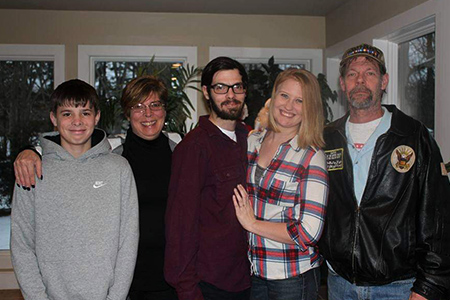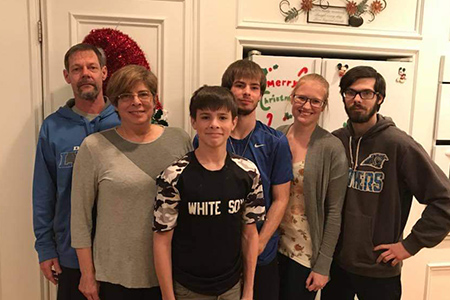A New Lease on Life
One Friday night, when Penne Caswell’s latest home breathing treatment wasn’t working, she told her husband she needed to go to the doctor.

“We had an auto start on our truck, and he started it up,” says Penne, 58, a retired legal secretary and resident of Hazel Park. “He went to the other room to get ready, and when he came back I said ‘call 911’ and dropped to the ground not breathing.”
Her husband yelled to their youngest son to call 911 as he gave her mouth-to-mouth. EMS arrived, started Penne on oxygen and then carried her out to the ambulance. They didn’t even take the time to put her on the stretcher.
Penne had been experiencing breathing issues for a few years, and her primary care physician had put her on breathing treatments. He suspected she may have chronic obstructive pulmonary disease (COPD), and recommended that she see a pulmonologist.
“Life was busy, and I put it off,” Penne says. “Until I couldn’t.”
After being rushed to her local ER, Penne spent five days in the ICU. Then several days in a regular hospital room. Once she was released, she started seeing a pulmonologist, who diagnosed her with emphysema, a specific type of COPD that is characterized by progressively increasing breathlessness. Penne had been a smoker for 30 years.
“My pulmonologist told me that if I didn’t quit smoking now, I would end up back in the ER again or worse,” Penne says. “I didn’t want to go back.”
Penne was determined to do what she could to improve her breathing.
“I saw my first pulmonologist for a year and a half, and I wasn’t getting any better,” she says. “He had me on steroids almost the whole time, and this made me gain 60 pounds. I couldn’t walk without losing my breath, and then he put me on oxygen.”
During this time, Penne’s mother-in-law started to see a different pulmonologist at another health system.
“I liked him, so I switched,” Penne says. “But after my second appointment, he told me that the next step would be a double lung transplant, and not much else could be done for me.”
A Transplant Workup … and a New Option
“He gave me a choice on where to go for my transplant, and I chose Henry Ford,” Penne says. “I had family treated here for other conditions. I also talked to my son’s doctors. He has cystic fibrosis and is treated at another health system. All of his doctors recommended Henry Ford.”
Penne started going through her workup for the transplant, but then hit a snag about six months in.
“One factor they look at is your oxygen level when you’re resting,” Penne says. “Mine was too high to make me a candidate. I would have to get worse to be considered.”
Instead, her Henry Ford Transplant team referred Penne’s CAT scan to the Pulmonary team. She met with Rebecca Priebe, NP, at Henry Ford Hospital, and Rebecca gave Penne her first good news.
“She told me that I was a good candidate for the BLVR procedure,” Penne says.
BLVR (bronchoscopic lung volume reduction) is a nonsurgical procedure that places tiny Zephyr® valves in a person’s airways to treat advanced emphysema. Zephyr is the first FDA-approved, minimally invasive device available in the U.S. for treating patients with severe emphysema.
Her Henry Ford team, including her surgeon, Michael Simoff, M.D., went over the procedure with her.
“They answered my questions, and I decided to do it,” Penne says. “I was only in my mid-fifties, and my other option was to keep trying to get on the lung transplant list. They tell you that after five years, the survival rate is only 50%. It was kind of a nothing to lose scenario.”
Still, Penne’s team worked to manage her expectations about the procedure.
“There were no guarantees,” she says. “They told me that having the procedure could immediately throw me on the transplant list, I could be the same or I could improve. And that I might still need to be on oxygen for the rest of my life.”
The Procedure, and the Recovery
 “It was pretty straightforward,” Penne says. “They prepped me and took me into the OR, and the next thing I knew, they were waking me up.”
“It was pretty straightforward,” Penne says. “They prepped me and took me into the OR, and the next thing I knew, they were waking me up.”
The initial recovery was difficult.
“It hurt to breathe,” Penne says. “My team said it was normal, and this was due to my top lobe collapsing. They gave me a pain shot, which helped.”
Penne was in the ICU for 24 hours before they transferred her to a regular room. Her progress was slow, but over time she began to see the results. This included stopping her oxygen usage, which is not an expected result of BLVR or the norm for many patients.
“I had resigned myself to the fact that I might never be off oxygen,” she says. “At first, if I was sitting down, I could take the oxygen off. They did periodic pulmonary function tests, and at 45 days, I had improved. A year after the procedure, I was feeling pretty good and took the oxygen off. It’s been almost a year since then, and I haven’t used it since.”
Her family is relieved.
“My younger boys wouldn’t even come to see me in the hospital,” Penne says. “They were 14 and 15 years old at that point, and they didn’t want to see me hooked up on machines. They were scared at what was going to happen. Now, my husband and kids are above and beyond ecstatic. They just try to make sure I don’t overdo it.”
While Penne is off the oxygen, she still uses a daily maintenance inhaler to treat the lung lobes that didn’t receive the BLVR treatment, and she also takes blood pressure medication, a water pill and calcium—a side effect of being on steroids for so long.
A New Perspective
“I had to face the fact that I almost died,” Penne says. “So I try not to let the little things bug me anymore.”
Instead, Penne is focused on spending more time with her family, and in making the most of her newfound energy.
“Just before the summer started, I began walking,” she says. “I was able to walk up to 1.5 miles around our subdivision. Before, I couldn’t carry more than a bag of bread, and now I can grab 6-8 bags of groceries. And for the first time in years, I can carry a purse.”
Penne also recognizes that while the BLVR procedure has helped improve many aspects of her life, she may not be out of the woods yet.
“I’m not cured, but I feel 100 percent better than I have felt in over a decade,” Penne says. “The procedure was worth it, even though I know I may need to get a transplant at some point. I still have emphysema in my other lung, and BLVR is only FDA approved for one lung. But I’m making the most of the time I have.”
And she’s grateful to her Henry Ford team for giving her this new lease on life.
“They speak to you like you’re a human,” Penne says. “They were very honest, but they never treated me like I was dying, even though when you go through something like this you’re pretty bad off. I never met a person who was having a bad day, or if they were, they didn’t show it. And that’s throughout the whole hospital. I have been on almost every floor, having a test of some sort. It made me confident that I was in the right place.”
.svg?iar=0&hash=F6049510E33E4E6D8196C26CCC0A64A4)

/hfh-logo-main--white.svg?iar=0&hash=ED491CBFADFB7670FAE94559C98D7798)